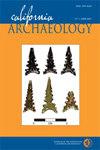Textile Impressions in California Archaeology: Analytical Considerations and Research Potential
IF 0.7
0 ARCHAEOLOGY
引用次数: 0
Abstract
ABSTRACTIn the absence of exceptional organic preservation, data on ancient textile industries can be recovered from intentional and accidental negative impressions of woven products left in media that are plastic or pliable initially, but which harden later. However, detailed studies of such textile impressions remain uncommon across the western United States. In California, where surviving plant-based organic artifacts are generally quite rare, impressions in asphaltum (bitumen) provide a means of acquiring data on textile crafts that are increasingly recognized for their potential to contribute to anthropological research questions. Here we review analytical considerations attendant to impressions analysis and explore the underappreciated research potential of textile impressions. Drawing on recent results from the detailed analysis of assemblages of textile impressions in asphaltum from two sites in California, we offer methodological suggestions and review the salient interpretive inferences from these studies that stand to enhance the research potential of similar assemblages.RESUMENLos datos sobre industrias textiles antiguas se pueden recuperar a partir de impresiones negativas, intencionales y accidentales de productos tejidos que se dejan en medios que inicialmente son plásticos o flexibles, pero que luego se endurecen. Embargo, estudio detallado de tales impresiones textiles sigue siendo poco común en el oeste de los Estados Unidos. En California, donde los artefactos orgánicos sobrevivientes son generalmente bastante raros, las impresiones en asfalto (betún) brindan un medio alternativo y complementario para adquirir datos sobre artesanías textiles que son cada vez más reconocidas por su potencial para contribuir a las preguntas de investigación antropológica. Basándonos en los resultados recientes del análisis detallado de ensamblajes de impresiones textiles en asfalto de dos sitios en California, ofrecemos sugerencias metodológicas y revisamos las inferencias interpretativas más destacadas de estos estudios que pueden mejorar el potencial de investigación de ensamblajes similares.KEYWORDS: Textilesbasketrywater bottleimpressionsasphaltumbitumenperishablespreservation AcknowledgementsThis article reflects a revision and expansion of Jolie’s (2020) unpublished agency report, and constructive comments provided by three anonymous reviewers and the editors have improved the quality of this contribution. We are grateful to the late Fred Segobia for his input and support, and the Salinan Tribe of Monterey and San Luis Obispo counties for permitting documentation of the funerary objects. Jolie's research on the Cache Cave material has been made possible by the Tejon Indian Tribe; the Barbareño/Ventureño Band of Mission Indians; Drs. David W. Robinson, Julienne Bernard, and John R. Johnson; and the Santa Barbara Museum of Natural History, with generous support from funding provided by the University of Central Lancashire and the Institute for Field Research. Additional thanks go to Judith K. Polanich, Gloria Howat Brown, Jan Timbrook, Will G. Russell, and Kurt Haas for assistance at various stages in this research, as well as to the late Charles Rozaire for his contributions to the literature on late Holocene cordage and twining industries from California's Channel Islands. David Hurst Thomas and Anibal Rodriguez made possible Jolie's examination of the water bottle at the American Museum of Natural History in New York, while Stephen Horne initiated the Mohr basket analysis that piqued Jolie's interest years ago.Disclosure StatementNo potential conflict of interest was reported by the author(s).Data Availability StatementAll data used in this article are available within the article or published in the cited works.Notes1 Apparent structural similarities (i.e., twining using tule and employing cordage warps) observed between southern California asphaltum-coated water bottles and so-called “Catlow Twine” twined weaving (Camp Citation2017; Citation2018; Connolly et al. Citation2016) from the ancient western and northern Great Basin are superficial and undercut by the absence of any water bottles manufactured via the Catlow Twine technique, as well as wider appreciation of just how ubiquitous Schoenoplectus (and related genera) cordage warps/wefts are in semi-flexible basket and bag or mat-based technologies in Indigenous North American weaving traditions.Additional informationFundingFunding for this research was provided by First Solar Electric Corporation as part of its compliance obligations for the California Flats Solar Project under Section 106 of the National Historic Preservation Act and California Environmental Quality Act.加州考古中的纺织品印象:分析思考和研究潜力
在缺乏特殊的有机保存的情况下,古代纺织工业的数据可以从有意和意外的负面印象中恢复,这些负面印象是在最初是塑料或柔韧的,但后来变硬的编织产品。然而,对这种纺织品印痕的详细研究在美国西部仍然不常见。在加利福尼亚,现存的植物有机制品通常相当罕见,沥青(沥青)上的印痕提供了一种获取纺织工艺数据的方法,这些纺织工艺越来越被认为有潜力为人类学研究问题做出贡献。在这里,我们回顾了印痕分析的分析考虑因素,并探讨了纺织品印痕的研究潜力。根据最近对加利福尼亚两个地点沥青中纺织印痕组合的详细分析结果,我们提供了方法学上的建议,并回顾了这些研究中突出的解释性推论,这些研究有助于提高类似组合的研究潜力。简历数据包括:工业、纺织品、纺织品、纺织品、纺织品、纺织品、纺织品、纺织品、纺织品、纺织品、纺织品、纺织品、纺织品、纺织品、纺织品、纺织品、纺织品、纺织品、纺织品、纺织品、纺织品、纺织品、纺织品、纺织品、纺织品、纺织品、纺织品、纺织品、纺织品等。禁运,工作室detallado de tales印象纺织品sigue siendo poco común en el oeste de los Estados Unidos。在加州,donde los artefactos orgánicos sobrevivientes son generalmente bastante raros, las imsimones En asfalto (betún) brinand and media alternative complementario para adquir datos sobre artesanías textiles que son cadas vez más reconocidas psu潜在的para contributor a las preguntas de investigación antropológica。Basándonos en los resultados recies del análisis detallado de ensamblajes de印象纺织品,en asfalto de dos sites en California, ofrecemos sugencias metodológicas通过revisamos las inferencias interpretativas más destacadas de estos estustudios que pueden mejorar和potentialde investigación de ensamblajes similares。本文对Jolie(2020)未发表的机构报告进行了修订和扩充,三位匿名审稿人和编辑提供的建设性意见提高了本文的质量。我们感谢已故的弗雷德·塞戈比亚的投入和支持,感谢蒙特利的萨利南部落和圣路易斯奥比斯波县允许对陪葬品进行记录。朱莉对Cache洞穴材料的研究是由Tejon印第安部落促成的;Barbareño/Ventureño印第安人传教团;Drs。大卫·w·罗宾逊、朱丽安·伯纳德和约翰·r·约翰逊;以及圣巴巴拉自然历史博物馆,并得到了中央兰开夏大学和野外研究所的慷慨资助。另外还要感谢Judith K. Polanich, Gloria Howat Brown, Jan Timbrook, Will G. Russell和Kurt Haas在本研究的各个阶段提供的帮助,以及已故的Charles Rozaire对全新世晚期加利福尼亚海峡群岛绳索和缠绕工业的文献贡献。大卫·赫斯特·托马斯和阿尼巴尔·罗德里格斯使朱莉在纽约美国自然历史博物馆对水瓶的研究成为可能,而斯蒂芬·霍恩则在几年前发起了莫尔篮子分析,引起了朱莉的兴趣。披露声明作者未报告潜在的利益冲突。数据可用性声明本文中使用的所有数据都可以在文章中或在引用的作品中获得。注1在南加州涂有沥青的水瓶和所谓的“猫绳线”缠绕编织之间观察到明显的结构相似性(即使用纤维缠绕和使用绳索绕线)(Camp Citation2017;Citation2018;康诺利等人。来自古代大盆地西部和北部的Citation2016)是肤浅的,因为没有任何用猫绳技术制造的水瓶,以及更广泛地认识到在北美土著编织传统的半柔性篮子和袋子或垫子技术中无处不在的Schoenoplectus(及相关属)绳索经线/纬线。本研究的资金由第一太阳能电力公司提供,作为其遵守《国家历史保护法》和《加州环境质质法》第106条规定的加州平原太阳能项目义务的一部分。
本文章由计算机程序翻译,如有差异,请以英文原文为准。
求助全文
约1分钟内获得全文
求助全文

 求助内容:
求助内容: 应助结果提醒方式:
应助结果提醒方式:


